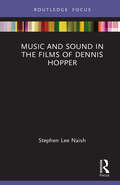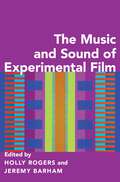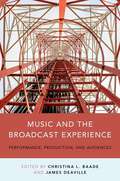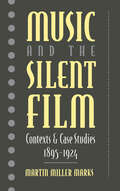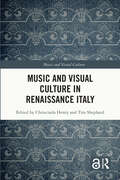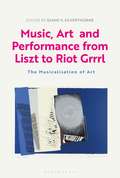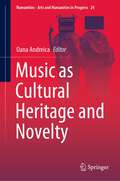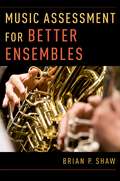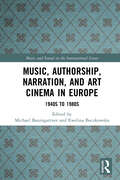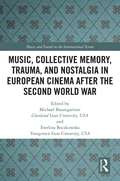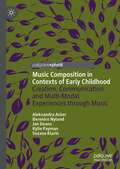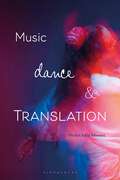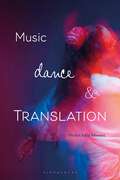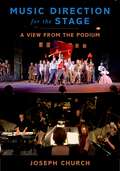- Table View
- List View
Music and Sound in the Films of Dennis Hopper (Filmmakers and Their Soundtracks)
by Stephen Lee NaishAcross his directorial films, American filmmaker Dennis Hopper used music and sound to propel the narrative, signpost the era in which the films were made, and delineate the characters’ place within American culture. This book explores five of Hopper’s films to show how this deep engagement with music to build character and setting continued throughout his career, as Hopper used folk, punk, hip-hop, and jazz to shape the worlds of his films in ways that influenced other filmmakers and foreshadowed the advent of the music video format.The author traces Hopper’s distinctive approach to the use of music through films from 1969 to 1990, including his innovative use of popular rock, pop, and folk in Easy Rider, his blending of diegetic performances of folk and Peruvian indigenous music in The Last Movie, his use of punk rock in Out of the Blue, incorporation of hip-hop and rap in Colors, and commissioning of a jazz/blues soundtrack by Miles Davis and John Lee Hooker for The Hot Spot. Uncovering the film soundtrack as a vital piece of the narrative, this concise and accessible book offers insights for academic readers in music and film studies, as well as all those interested in Hopper’s work.
Music and Sound in the Films of Dennis Hopper (Filmmakers and Their Soundtracks)
by Stephen Lee NaishAcross his directorial films, American filmmaker Dennis Hopper used music and sound to propel the narrative, signpost the era in which the films were made, and delineate the characters’ place within American culture. This book explores five of Hopper’s films to show how this deep engagement with music to build character and setting continued throughout his career, as Hopper used folk, punk, hip-hop, and jazz to shape the worlds of his films in ways that influenced other filmmakers and foreshadowed the advent of the music video format.The author traces Hopper’s distinctive approach to the use of music through films from 1969 to 1990, including his innovative use of popular rock, pop, and folk in Easy Rider, his blending of diegetic performances of folk and Peruvian indigenous music in The Last Movie, his use of punk rock in Out of the Blue, incorporation of hip-hop and rap in Colors, and commissioning of a jazz/blues soundtrack by Miles Davis and John Lee Hooker for The Hot Spot. Uncovering the film soundtrack as a vital piece of the narrative, this concise and accessible book offers insights for academic readers in music and film studies, as well as all those interested in Hopper’s work.
The Music and Sound of Experimental Film
This book explores music/sound-image relationships in non-mainstream screen repertoire from the earliest examples of experimental audiovisuality to the most recent forms of expanded and digital technology. It challenges presumptions of visual primacy in experimental cinema and rethinks screen music discourse in light of the aesthetics of non-commercial imperatives. Several themes run through the book, connecting with and significantly enlarging upon current critical discourse surrounding realism and audibility in the fiction film, the role of music in mainstream cinema, and the audiovisual strategies of experimental film. The contributors investigate repertoires and artists from Europe and the USA through the critical lenses of synchronicity and animated sound, interrelations of experimentation in image and sound, audiovisual synchresis and dissonance, experimental soundscape traditions, found-footage film, re-mediation of pre-existent music and sound, popular and queer sound cultures, and a diversity of radical technological, aesthetic, tropes in film media traversing the work of early pioneers such as Walther Ruttmann and Len Lye, through the mid-century innovations of Norman McLaren, Stan Brakhage, Lis Rhodes, Kenneth Anger, Andy Warhol, and studio collectives in Poland, to latter-day experimentalists John Smith and Bill Morrison, as well as the contemporary practices of Vjing.
Music and the Broadcast Experience: Performance, Production, and Audiences
Music and the Broadcast Experience explores the complex ways in which music and broadcasting have developed together throughout the twentieth and into the twenty-first centuries. It brings into dialogue researchers working in media and music studies; explores and develops crucial points of contact between studies of music in radio and music in television; and investigates the limits, persistence, and extensions of music broadcasting in the Internet era. The book presents a series of case studies that address key moments and concerns in music broadcasting, past and present, written by leading scholars in the field, who hail from both media and music studies. Unified by attentiveness both to musical sound and meaning and to broadcasting structures, practices, audiences, and discourses, the chapters in this collection address the following topics: the role of live orchestral concerts and opera in the early development of radio and their relation to ideologies of musical uplift; the relation between production culture, music, and television genre; the function of music in sponsored radio during the 1930s; the fortunes of musical celebrity and artistic ambition on television; questions of music format and political economy in the development of online radio; and the negotiation of space, community, and participation among audiences, online and offline, in the early twenty-first century. The collection's ultimate aim is to explore the usefulness and limitations of broadcasting as a concept for understanding music and its cultural role, both historically and today.
Music and the Silent Film: Contexts and Case Studies, 1895-1924
by Martin Miller MarksIn this book, a leading authority on film music examines scores of the silent film era. The first of three projected volumes investigating music written for films, this thoughtful and pathbreaking study demonstrates the richness of silent film music as it details the way in which scores were often planned from the start as an integral part of the whole cinematic experience. Following an introductory chapter that outlines several key theoretical questions and surveys eight decades of writing on film music, Martin Miller Marks focuses on those scores created between 1895 and 1924. He begins by considering two early examples, one German (written by persons unknown for Skladanowsky's Bioskop exhibitions in 1895 and 1896) and one French (scored by Camille Saint-Saëns for the 1908 film L'Assassinat du Duc de Guise). Subsequent chapters fully discuss Walter Cleveland Simon's music for the American film An Arabian Tragedy (1912) as well as the Joseph Breil accompaniment to D. W. Griffith's Birth of a Nation (1915). As described in this book, Breil's memorable score--though a compilation derived from many sources--was played by an orchestra as Griffith's sweeping images filled the screen, thus contributing significantly to the great film's success while also achieving remarkable power in its own right. Marks then concludes with a look at Erik Satie's witty and innovative music for the French film Entr'acte (1924), which was the first film score of consequence by an avant-garde composer. Giving unprecedented attention to a vibrant, important, and oft-neglected facet of twentieth-century music, Music and the Silent Film will interest scholars of film theory, film history, modern music, and modern aesthetics.
Music and Visual Culture in Renaissance Italy (Music and Visual Culture)
by Chriscinda Henry Tim ShephardThe chapters in this volume explore the relationship between music and art in Italy across the long sixteenth century, considering an era when music-making was both a subject of Italian painting and a central metaphor in treatises on the arts. Beginning in the fifteenth century, transformations emerge in the depiction of music within visual arts, the conceptualization of music in ethics and poetics, and in the practice of musical harmony. This book brings together contributors from across musicology and art history to consider the trajectories of these changes and the connections between them, both in theory and in the practices of everyday life. In sixteen chapters, the contributors blend iconographic analysis with a wider range of approaches, investigate the discourse surrounding the arts, and draw on both social art history and the material turn in Renaissance studies. They address not only paintings and sculpture, but also a wide range of visual media and domestic objects, from instruments to tableware, to reveal a rich, varied, and sometimes tumultuous exchange among musical and visual arts and ideas. Enriching our understanding of the subtle intersections between visual, material, and musical arts across the long Renaissance, this book offers new insights for scholars of music, art, and cultural history. Chapter 15 of this book is freely available as a downloadable Open Access PDF at http://www.taylorfrancis.com under a Creative Commons Attribution-Non Commercial-No Derivatives (CC-BY-NC-ND) 4.0 license.
Music and Visual Culture in Renaissance Italy (Music and Visual Culture)
The chapters in this volume explore the relationship between music and art in Italy across the long sixteenth century, considering an era when music-making was both a subject of Italian painting and a central metaphor in treatises on the arts. Beginning in the fifteenth century, transformations emerge in the depiction of music within visual arts, the conceptualization of music in ethics and poetics, and in the practice of musical harmony. This book brings together contributors from across musicology and art history to consider the trajectories of these changes and the connections between them, both in theory and in the practices of everyday life. In sixteen chapters, the contributors blend iconographic analysis with a wider range of approaches, investigate the discourse surrounding the arts, and draw on both social art history and the material turn in Renaissance studies. They address not only paintings and sculpture, but also a wide range of visual media and domestic objects, from instruments to tableware, to reveal a rich, varied, and sometimes tumultuous exchange among musical and visual arts and ideas. Enriching our understanding of the subtle intersections between visual, material, and musical arts across the long Renaissance, this book offers new insights for scholars of music, art, and cultural history. Chapter 15 of this book is freely available as a downloadable Open Access PDF at http://www.taylorfrancis.com under a Creative Commons Attribution-Non Commercial-No Derivatives (CC-BY-NC-ND) 4.0 license.
Music, Art and Performance from Liszt to Riot Grrrl: The Musicalization of Art
by Diane V. SilverthorneOpening with an account of print portraiture facilitating Franz Liszt's celebrity status and concluding with Riot Grrrl's noisy politics of feminism and performance, this interdisciplinary anthology charts the relationship between music and the visual arts from late Romanticism and the birth of modernism to 'postmodernism', while crossing from Western art to the Middle East. Focused on music as a central experience of art and life, these essays scrutinize 'the musicalisation of art' focusing on the visual and performing arts and detailing significant instances of intra-art relations between c. 1840 and the present day. Essays reflect on the aesthetic relationships of music to painting, performance and installation, sound-and- silence, time-and-space. The insistent influence of Wagner is considered as well as the work and ideas of Manet, Satie and Cage, Thomas Wilfred, La Monte Young and Eliasson. What distinguishes these studies are the convictions that music is never alone and that a full understanding of the “isms” of the last two hundred years is best achieved when music's influential presence in the visual arts is acknowledged and interrogated.
Music, Art and Performance from Liszt to Riot Grrrl: The Musicalization of Art (Criminal Practice Ser.)
by Diane V. SilverthorneOpening with an account of print portraiture facilitating Franz Liszt's celebrity status and concluding with Riot Grrrl's noisy politics of feminism and performance, this interdisciplinary anthology charts the relationship between music and the visual arts from late Romanticism and the birth of modernism to 'postmodernism', while crossing from Western art to the Middle East. Focused on music as a central experience of art and life, these essays scrutinize 'the musicalisation of art' focusing on the visual and performing arts and detailing significant instances of intra-art relations between c. 1840 and the present day. Essays reflect on the aesthetic relationships of music to painting, performance and installation, sound-and- silence, time-and-space. The insistent influence of Wagner is considered as well as the work and ideas of Manet, Satie and Cage, Thomas Wilfred, La Monte Young and Eliasson. What distinguishes these studies are the convictions that music is never alone and that a full understanding of the “isms” of the last two hundred years is best achieved when music's influential presence in the visual arts is acknowledged and interrogated.
Music as a Chariot: The Evolutionary Origins of Theatre in Time, Sound, and Music
by Richard K. ThomasMusic as a Chariot offers a multidisciplinary perspective whose primary proposition is that theatre is a type of music. Understanding how music enables the theatre experience helps to shape our entire approach to the performing arts. Beginning with a discussion on the origin and nature of time, the author takes us on an evolutionary journey to discover how music, language and mimesis co-evolved, eventually coming together to produce the complex way we experience theatre. The book integrates the evolutionary neuroscience of the human brain into this journey, offering practical implications and applications for the auditory expression of this concept—namely the fundamental techniques artists use to create sound scores for theatre. With contributions from directors, playwrights, actors and designers, Music as a Chariot explores the use of music to carry ideas into the human soul—a concept that extends beyond the theatrical to include film, video gaming, dance, or anywhere art is manipulated in time.
Music as a Chariot: The Evolutionary Origins of Theatre in Time, Sound, and Music
by Richard K. ThomasMusic as a Chariot offers a multidisciplinary perspective whose primary proposition is that theatre is a type of music. Understanding how music enables the theatre experience helps to shape our entire approach to the performing arts. Beginning with a discussion on the origin and nature of time, the author takes us on an evolutionary journey to discover how music, language and mimesis co-evolved, eventually coming together to produce the complex way we experience theatre. The book integrates the evolutionary neuroscience of the human brain into this journey, offering practical implications and applications for the auditory expression of this concept—namely the fundamental techniques artists use to create sound scores for theatre. With contributions from directors, playwrights, actors and designers, Music as a Chariot explores the use of music to carry ideas into the human soul—a concept that extends beyond the theatrical to include film, video gaming, dance, or anywhere art is manipulated in time.
Music as Cultural Heritage and Novelty (Numanities - Arts and Humanities in Progress #24)
by Oana AndreicaThis book provides a multifaceted view on the relation between the old and the new in music, between tradition and innovation. This is a much-debated issue, generating various ideas and theories, which rarely come to unanimous conclusions. Therefore, the book offers diverse perspectives on topics such as national identities, narrative strategies, the question of musical performance and musical meaning. Alongside themes of general interest, such as classical repertoire, the music of well-established composers and musical topics, the chapters of the book also touch on specific, but equally interesting subjects, like Brazilian traditions, Serbian and Romanian composers and the lullaby. While the book is mostly addressed to researchers, it can also be recommended to students in musicology, ethnomusicology, musical performance, and musical semiotics.
Music Assessment for Better Ensembles
by Brian P. ShawAssessment is central to ensemble music. Yet, teachers do not always have the expertise to harness its potential to improve rehearsals and performances, and promote and document student learning. Written specifically for band, choir, and orchestra teachers at all levels, this book contains all of the information necessary to design and use assessment in a thriving music classroom. The first section addresses foundations such as learning targets, metacognition, and growth mindset. Assessment jargon such as formative assessment, summative assessment, Assessment for Learning, self and peer assessment, and authentic assessment is clarified and illustrated with music examples. Readers will learn practical strategies for choosing which concepts to assess, which methods to use, and how to use results to provide accurate and effective feedback to students. The second section brings assessment fundamentals into the music room. Filled with practical advice, each chapter examines a different facet of musicianship. Sample assessments in all performance areas are provided, including music literacy, fundamentals and technique, terminology, interpretation, evaluation and critique, composition and improvisation, beliefs and attitudes, and more. There is an entire chapter devoted to tips for applying assessment and feedback strategies in rehearsals, which can result in a fresh and effective approach to performance preparation. The final section is an examination of grading practices in music classes. Readers will gain information about ensemble grades that communicate what students know and are able to do, rather than whether they remembered their black socks. A variety of approaches, including Standards-Based Grading, are evaluated in light of music teachers' unique situations. The book concludes with ways for music educators to take their first steps toward implementing these strategies in their own teaching, including the use of instructional technology. Assessing like an expert is possible, and this book is just what teachers need to get started.
Music Assessment for Better Ensembles
by Brian P. ShawAssessment is central to ensemble music. Yet, teachers do not always have the expertise to harness its potential to improve rehearsals and performances, and promote and document student learning. Written specifically for band, choir, and orchestra teachers at all levels, this book contains all of the information necessary to design and use assessment in a thriving music classroom. The first section addresses foundations such as learning targets, metacognition, and growth mindset. Assessment jargon such as formative assessment, summative assessment, Assessment for Learning, self and peer assessment, and authentic assessment is clarified and illustrated with music examples. Readers will learn practical strategies for choosing which concepts to assess, which methods to use, and how to use results to provide accurate and effective feedback to students. The second section brings assessment fundamentals into the music room. Filled with practical advice, each chapter examines a different facet of musicianship. Sample assessments in all performance areas are provided, including music literacy, fundamentals and technique, terminology, interpretation, evaluation and critique, composition and improvisation, beliefs and attitudes, and more. There is an entire chapter devoted to tips for applying assessment and feedback strategies in rehearsals, which can result in a fresh and effective approach to performance preparation. The final section is an examination of grading practices in music classes. Readers will gain information about ensemble grades that communicate what students know and are able to do, rather than whether they remembered their black socks. A variety of approaches, including Standards-Based Grading, are evaluated in light of music teachers' unique situations. The book concludes with ways for music educators to take their first steps toward implementing these strategies in their own teaching, including the use of instructional technology. Assessing like an expert is possible, and this book is just what teachers need to get started.
Music, Authorship, Narration, and Art Cinema in Europe: 1940s to 1980s (Music and Sound on the International Screen)
by Michael Baumgartner Ewelina BoczkowskaMusic, Authorship, Narration, and Art Cinema in Europe: 1940s to 1980s investigates the function of music in European cinema after the Second World War up to the fall of the Berlin wall, a period when composers and directors embraced experimentation. Through analyses of music and sound in a wide range of iconic films from across Europe, the essays in this book provide a nuanced reconsideration of three core themes: auteur theory, art house film, and national cinema. Chapters written by an international array of contributors focus on case studies of music in the cinema of Carlos Saura, Jean-Pierre Melville, the Polish School, and Romanian directors, as well as collaborations between directors and composers, including Michelangelo Antonioni and Giovanni Fusco, Federico Fellini and Nino Rota, Leo Arnshtam and Dmitry Shostakovich, and Peter Greenaway and Michael Nyman. The contributors shift the emphasis from a director-centered view to the working relationship between director and composer, and from the visual component to the sonic aspects of these films, without ignoring the close correlation between soundtrack and visual elements. Enriching our understanding of the complex, intertwined nature of authorship in film, the role of film music, and sound, nation-state and art cinema, and European cinematic history, this volume offers a valuable addition to research across music and film studies.
Music, Authorship, Narration, and Art Cinema in Europe: 1940s to 1980s (Music and Sound on the International Screen)
by Michael Baumgartner Ewelina BoczkowskaMusic, Authorship, Narration, and Art Cinema in Europe: 1940s to 1980s investigates the function of music in European cinema after the Second World War up to the fall of the Berlin wall, a period when composers and directors embraced experimentation. Through analyses of music and sound in a wide range of iconic films from across Europe, the essays in this book provide a nuanced reconsideration of three core themes: auteur theory, art house film, and national cinema. Chapters written by an international array of contributors focus on case studies of music in the cinema of Carlos Saura, Jean-Pierre Melville, the Polish School, and Romanian directors, as well as collaborations between directors and composers, including Michelangelo Antonioni and Giovanni Fusco, Federico Fellini and Nino Rota, Leo Arnshtam and Dmitry Shostakovich, and Peter Greenaway and Michael Nyman. The contributors shift the emphasis from a director-centered view to the working relationship between director and composer, and from the visual component to the sonic aspects of these films, without ignoring the close correlation between soundtrack and visual elements. Enriching our understanding of the complex, intertwined nature of authorship in film, the role of film music, and sound, nation-state and art cinema, and European cinematic history, this volume offers a valuable addition to research across music and film studies.
Music, Collective Memory, Trauma, and Nostalgia in European Cinema after the Second World War (Music and Sound on the International Screen)
by Michael Baumgartner Ewelina BoczkowskaIn the wake of World War II, the arts and culture of Europe became a site where the devastating events of the 20th century were remembered and understood. Exploring one of the most integral elements of the cinematic experience—music—the essays in this volume consider the numerous ways in which post-war European cinema dealt with memory, trauma and nostalgia, showing how the music of these films shaped the representation of the past. The contributors consider films from the United Kingdom, Poland, the Soviet Union, France, Italy, Germany, Sweden, Austria, and the Netherlands, providing a diverse and well-rounded understanding of film music in the context of historical memory. Memory is often underrepresented within scholarly musical studies, with most of these applications found in the disciplines of ethnomusicology, popular music studies, music cognition, and psychology and music therapy. Likewise, trauma has mainly been studied in relation to music in only a few historical contexts, while nostalgia has attracted even less academic attention. In three parts, this volume addresses each area of study as it relates to the music of European cinema from 1945 to 1989, applying an interdisciplinary approach to investigate how films use music to negotiate the precarious relationships we maintain with the past. Music, Collective Memory, Trauma, and Nostalgia in European Cinema after the Second World War offers compelling arguments as to what makes music such a powerful medium for memory, trauma and nostalgia.
Music, Collective Memory, Trauma, and Nostalgia in European Cinema after the Second World War (Music and Sound on the International Screen)
by Michael Baumgartner Ewelina BoczkowskaIn the wake of World War II, the arts and culture of Europe became a site where the devastating events of the 20th century were remembered and understood. Exploring one of the most integral elements of the cinematic experience—music—the essays in this volume consider the numerous ways in which post-war European cinema dealt with memory, trauma and nostalgia, showing how the music of these films shaped the representation of the past. The contributors consider films from the United Kingdom, Poland, the Soviet Union, France, Italy, Germany, Sweden, Austria, and the Netherlands, providing a diverse and well-rounded understanding of film music in the context of historical memory. Memory is often underrepresented within scholarly musical studies, with most of these applications found in the disciplines of ethnomusicology, popular music studies, music cognition, and psychology and music therapy. Likewise, trauma has mainly been studied in relation to music in only a few historical contexts, while nostalgia has attracted even less academic attention. In three parts, this volume addresses each area of study as it relates to the music of European cinema from 1945 to 1989, applying an interdisciplinary approach to investigate how films use music to negotiate the precarious relationships we maintain with the past. Music, Collective Memory, Trauma, and Nostalgia in European Cinema after the Second World War offers compelling arguments as to what makes music such a powerful medium for memory, trauma and nostalgia.
Music Composition in Contexts of Early Childhood: Creation, Communication and Multi-Modal Experiences through Music
by Jan Deans Berenice Nyland Aleksandra Acker Kylie Payman Suzana KlarinThis book explores the narratives of a group of four-year-old children in a composition project in an Australian early learning centre. The participants, centre staff and a composer, Stephen Leek, contributed a number of music sessions for the children, including five original songs. The book showcases young children’s communicative ability and sensitivity to wider issues. The staff in the centre have a strongly voiced philosophy that is enacted through arts-based pedagogy and incorporates significant themes including a respect for Aboriginal culture and custodial responsibility towards a sustainable future for the earth. Examples of adult and children’s ideas are illustrated through music making, singing, dancing, words, drawings and paintings, which provide insights into a world where children are viewed as active citizens and the arts have rights. The book describes the context of the centre, the history of projects and details one project as an example of “lifeworthy learning”.
Music \= Cultures in Contact: Convergences and Collisions (Musicology)
by Margaret J. Kartomi Stephen BlumFirst Published in 1995. Routledge is an imprint of Taylor & Francis, an informa company.
Music \= Cultures in Contact: Convergences and Collisions (Musicology #16)
by Margaret J. Kartomi Stephen BlumFirst Published in 1995. Routledge is an imprint of Taylor & Francis, an informa company.
Music, Dance and Translation
by Helen Julia MinorsHow is music affected by its translation, interpretation and adaptation with, through, and by dance? How might notation of dance and music act as a form of translation? How does music influence the creation of dance? How might dance and music be understood to exchange and transfer their content, sense and process during both the creative process and the interpretative process? Bringing together chapters that explore theory and practice, this book questions the process and role translation has to play in the context of music and dance. It provides a range of case studies across this interdisciplinary field, and is not restricted by genre, style or cultural location. As one of very few volumes to explore translation in relation to music and to overtly tackle this topic in terms of dance, it moves the argument from a broad notion of text and translation, to think critically about the sound and movement arts of music and dance, using translation as a model to better understand the collaboration of these art forms.
Music, Dance and Translation
How is music affected by its translation, interpretation and adaptation with, through, and by dance? How might notation of dance and music act as a form of translation? How does music influence the creation of dance? How might dance and music be understood to exchange and transfer their content, sense and process during both the creative process and the interpretative process? Bringing together chapters that explore theory and practice, this book questions the process and role translation has to play in the context of music and dance. It provides a range of case studies across this interdisciplinary field, and is not restricted by genre, style or cultural location. As one of very few volumes to explore translation in relation to music and to overtly tackle this topic in terms of dance, it moves the argument from a broad notion of text and translation, to think critically about the sound and movement arts of music and dance, using translation as a model to better understand the collaboration of these art forms.
MUSIC DIRECTION FOR STAGE C: A View from the Podium
by Joseph ChurchTheater music directors must draw on a remarkably broad range of musical skills. Not only do they conduct during rehearsals and performances, but they must also be adept arrangers, choral directors, vocal coaches, and accompanists. Like a record producer, the successful music director must have the flexibility to adjust as needed to a multifaceted job description, one which changes with each production and often with each performer. In Music Direction for the Stage, veteran music director and instructor Joseph Church demystifies the job in a book that offers aspiring and practicing music directors the practical tips and instruction they need in order to mount a successful musical production. Church, one of Broadway's foremost music directors, emerges from the orchestra pit to tell how the music is put into a musical show. He gives particular attention to the music itself, explaining how a music director can best plan the task of learning, analyzing, and teaching each new piece. Based on his years of professional experience, he offers a practical discussion of a music director's methods of analyzing, learning, and practicing a score, thoroughly illustrated by examples from the repertoire. The book also describes how a music director can effectively approach dramatic and choreographic rehearsals, including key tips on cueing music to dialogue and staging, determining incidental music and underscoring, making musical adjustments and revisions in rehearsal, and adjusting style and tempo to performers' needs. A key theme of the book is effective collaboration with other professionals, from the production team to the creative team to the performers themselves, all grounded in Church's real-world experience with professional, amateur, and even student performances. He concludes with a look at music direction as a career, offering invaluable advice on how the enterprising music director can find work and gain standing in the field.
Music Direction for the Stage: A View from the Podium
by Joseph ChurchTheater music directors must draw on a remarkably broad range of musical skills. Not only do they conduct during rehearsals and performances, but they must also be adept arrangers, choral directors, vocal coaches, and accompanists. Like a record producer, the successful music director must have the flexibility to adjust as needed to a multifaceted job description, one which changes with each production and often with each performer. In Music Direction for the Stage, veteran music director and instructor Joseph Church demystifies the job in a book that offers aspiring and practicing music directors the practical tips and instruction they need in order to mount a successful musical production. Church, one of Broadway's foremost music directors, emerges from the orchestra pit to tell how the music is put into a musical show. He gives particular attention to the music itself, explaining how a music director can best plan the task of learning, analyzing, and teaching each new piece. Based on his years of professional experience, he offers a practical discussion of a music director's methods of analyzing, learning, and practicing a score, thoroughly illustrated by examples from the repertoire. The book also describes how a music director can effectively approach dramatic and choreographic rehearsals, including key tips on cueing music to dialogue and staging, determining incidental music and underscoring, making musical adjustments and revisions in rehearsal, and adjusting style and tempo to performers' needs. A key theme of the book is effective collaboration with other professionals, from the production team to the creative team to the performers themselves, all grounded in Church's real-world experience with professional, amateur, and even student performances. He concludes with a look at music direction as a career, offering invaluable advice on how the enterprising music director can find work and gain standing in the field.
